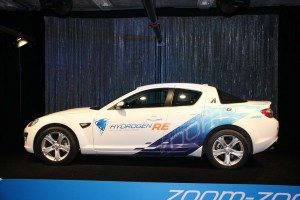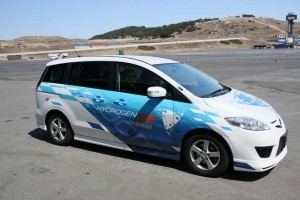
It looks like a conventional Mazda RX-8, but it's powered by clean hydrogen.
There’s a buzzing noise coming from under the hood. It sounds a bit like an old airplane I think, but my co-pilot is less charitable: “a vacuum cleaner that’s just swallowed something big,” she offers.
It takes a bit of getting used to driving advanced technology, I’ve learned over the years, especially when it’s not yet ready for prime time, but it’s still quite revealing to get behind the wheel of this particular Mazda RX-8. Despite its modest – and hopefully temporary – drawbacks, this sports car prototype could be the way of the future for the automobile.
That’s because it’s running on hydrogen, rather than gasoline. The lightweight gas has been hailed as the potential breakthrough the auto industry needs because it could cut our ties to imported oil and, just as importantly, eliminate the production of noxious tailpipe emissions, including CO2, which has been linked to global warming. Burn hydrogen and the only exhaust gas is water vapor and the slightest trace of NOx. Before the e-mails start, I know, the big emissions problem is how you make the hydrogen.

The Mazda Hydrogen RE Premacy - a Mazda5 - operates much like the Chevrolet Volt, with the engine serving only as a generator for the vehicle's electric motors.
Most manufacturers are focused on using hydrogen to power fuel cells. These devices combine the gas with oxygen to produce electric current, power that, in turn, is used to run electric motors. Honda, for example, has a small fleet of hydrogen-powered FCX cars running around California using fuel cell technology.
Mazda has taken a decidedly different approach. It prefers to burn hydrogen in its time-tested rotary engines. That has several advantages, according to Akihiro Kashiwagi, head of the Hydrogen RE – short for Rotary Engine – project. Most importantly, it requires only some relatively modest changes to existing powertrain technology. In the case of the Hydrogen RE RX-8, that means a high-pressure storage tank, special fuel injectors and some tweaks to the engine’s rotors. By comparison, fuel cell technology would require a massive shift in design, engineering and manufacturing, among other things.
There are some trade-offs, however. For one thing, Mazda’s approach isn’t quite as efficient. Indeed, one of the drawbacks of the company’s trademark rotary engine is that it’s not as fuel-efficient as the classic piston engine. And there is that trace amount of smog-causing NOx, which must be cleaned up. But the Japanese maker is betting that its approach can help launch the so-called “hydrogen economy” quite a bit sooner than waiting for the development of fuel cell technology, which is still quite some time away.
We have the opportunity, this warm afternoon, at the Laguna Seca Raceway, to try two very different versions of the Mazda Hydrogen RE system. The technology under the hood of the RX-8 is reasonably familiar. I slip behind the wheel, crank the key, and two seconds later, a ready light pops up on the instrument panel. I shift to “D,” and the car comes to life.

The author at the wheel of the hydrogen-powered Mazda Premacy.
To handle hydrogen, Mazda engineers had to de-tune the engine. In the Hydrogen RE, it churns out just 108 horsepower, about half as much as the conventional RX-8. And though it’s not quite an apples-to-apples equation, there’s no mistaking the loss of performance as I squeeze the throttle to the floorboard. It’s not a stone pony, but the configuration seems to have taken the “sport” out of sports car.
Then there’s the odd buzzing. A rotary engine, by nature, has a decidedly different sound than a conventional piston engine, but here that turns into a strangely aeronautical thrum. The Mazda engineer, who has come along for the ride, advises us, however, that in production, much of that unpleasant sound could be masked.
Beyond those two drawbacks, this is, for all intents and purposes, a Mazda RX-8, as we’re reminded looping through the roads that wind through the hills surrounding the track itself, nimble and fun to drive.
Another drawback of hydrogen is that it’s tough to store a lot of it. Even with a 5000 psi tank of the gaseous fuel, the RE Mazda RX-8 only gets about 60 miles range. But the car also has a conventional gasoline tank, and one can switch between fuels at the touch of a button, even while moving.
Mazda has, however, doubled the range of its other prototype Hydrogen RE vehicle, a version of the Japanese Premacy – known to American buyers as the Mazda5 minivan. That’s only one of several significant changes in this newer approach to using hydrogen power.
The Premacy is, in fact, very similar to the Chevrolet Volt, in that it is a serial hybrid. The wheels derive their power solely from the vehicle’s electric motor which, in turn, is connected to both a lithium-ion battery and a hydrogen-powered rotary engine. That engine, in other words, acts only as a generator.
When driving, then, power can come from the battery, from the generator or from a combination of the two, if you’re accelerating hard. At low speeds, the battery alone is used. And says Kashiwagi, “In the future, this system could easily be converted to a plug-in hybrid,” like Volt, by increasing the size of the LIon battery. That would allow the vehicle to travel for 20, 30, 40 miles or more solely on electric power.
As with the Hydrogen RE RX-8, there’s a fair amount of buzzing from the Premacy. There’s also the drawback of giving up the third row of seats to make room for a big tank of hydrogen. But there’s still enough space for five passengers.
Like the other hydrogen vehicles I have driven, the Mazda Hydrogen RE technology still has a fair bit of work to be done before it could be sold to the public. But the automaker’s system is reasonably familiar and relatively easy to bring to market. The bigger challenge would be to find motorists a ready source of hydrogen. Creating a nationwide fueling infrastructure is likely decades away.
Nonetheless, there are a few sources on the road, right now, including a public filling station in Irvine, CA, near Mazda’s headquarters. The test fleet of Honda FCX vehicles makes use of that operation. And Mazda officials say they may, as well, by launching a U.S. test fleet in the near future.
Will hydrogen ever make it from concept to customer? Such a project could make the difference.
